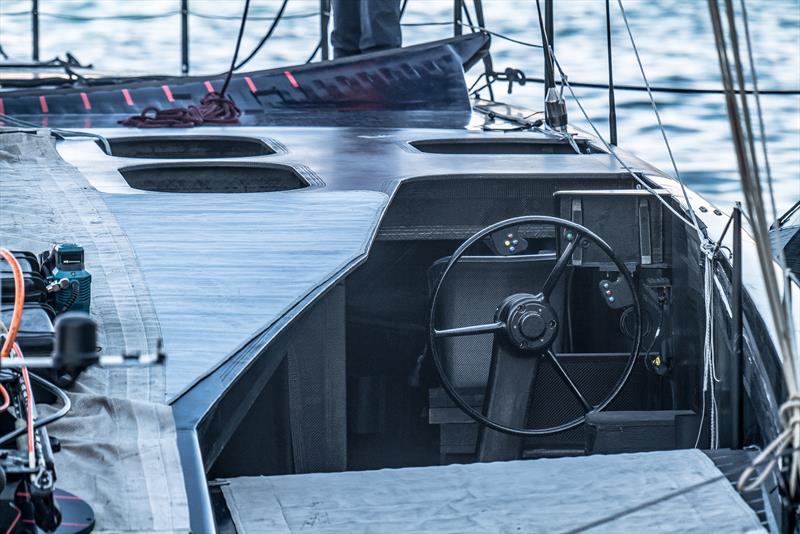
Cup Spy March 1: Swiss unveil cyclist friendly deck layout
by Richard Gladwell/Sail-world.com/nz 2 Mar 2023 08:02 UTC
2 March 2023

Crew pits have been created in place of a trench - AC75 - Alinghi Red Bull Racing - March 1, 2023 - Barcelona © Alex Carabi / America's Cup
Alinghi Red Bull Racing - AC75 - Barcelona - March 1, 2023 - Day 45
On Wednesday, Alinghi Red Bull Racing rolled out their modified AC75, the former first generation AC75 from Emirates Team New Zealand.
The AC75, known by the Swiss as "B1" was last sailed on February 12. The former Te Aihe had plenty of gaps on their dance card in February, after a very active January. The Swiss only sailed their AC75 on three days in the month. On February 1 - they probably cleaned up the spillover testing from the January testing block. They launched again on February 10, for a rigging and system test session, with the AC37 Joint Recon Team saying that the Swiss had been kept ashore by a week long storm. They sailed two days later on February 12, and then it was back into the building shed for over two weeks, emerging on March 1.
There were some significant changes made in the intervening fortnight, which are noted below by the AC37 Joint Recon team and their accompanying images.
Most obvious was a rework of the deck structure, with an inboard set of two pits being created port and starboard - presumably to carry cyclists to pressure up the hydraulic systems. There are four new deck cutouts for cyclists, and with a new hatch being created just behind the jib traveller and also adjacent to the mast base. Unlike the hull surface, the deck surface is allowed unlimited change under the America's Cup rules.
A shot taken as B1 rolled to weather during an earlier sail reveals the extent of the changes, which altered the crew trench either side of a centre console - essentially the original design from Emirates Team NZ - and creating the bike pits.
The Swiss team are the second America's Cup to proceed with cyclists in place of hand powered grinders. American Magic trialed the concept in their AC75, before decommissioning Patriot, their AC75 from the 2021 America's Cup, in early February.
On Wednesday they launched and sailed their first AC-40 from their base in Pensacola, Florida.
Alinghi Red Bull Racing's wide topped rudder which made an appearance in January - believed to be a legacy item from Emirates Team NZ has been slimmed down, and a new curved elevator fitted, with an interesting spike on its front edge.
Cup scuttlebutt has assumed that crews will remain on one allocated side - taking the lead from Luna Rossa in the last America's Cup, where co-helmsmen Jimmy Spithill and Francesco Bruni remained in their starboard and port fox-holes, while the rest of the allowed 11 crew crossed sides between tacks/gybes.
It remains to be seen how the now eight permitted crew move around between tacks. From the new layout our guess is that up to four cyclists will remain in their fox-holes, and one of the objectives of the next test block will be to determine who actually move between tacks/gybes. Allocating four dedicated crew to cycling duties would seem to be excessive, and there will likely be two dedicated cyclists, with others dropping in as required. Also to be worked out is how the flight control, sail trimming and helming responsibilities are shared, around the crew and pits.
One of the questions to be answered will be whether the team needs two, three or four dedicated cyclists/grinders.
In the 2017 America's Cup, flight controller Blair Tuke performed his task while being on a cycle, however the way flight control system has changed from the 2017 Cup, means that a dedicated flight controller will be required.
B1 was not sailed but the crew spent 30 minutes on sail-hoisting.
From the AC37 Joint Recon team:
Alinghi Red Bull Racing rolled out their AC75 at 09:10.
A few modifications have been made to the AC75 while it has been in the shed for the past two and a half weeks. With a large residual swell and Garbi winds, the team did not sail, instead using the day to test and tune the systems onboard.
It was noticed immediately as the yacht was rolled out, that the rudder and elevator have been replaced. The new rudder profile has as a slightly more aggressive taper to shorten the chord of the rudder foil. The new elevator is a curved anhedral foil, with a seemingly larger wingspan and a slightly pronounced nose.
Once the yacht was craned in, the new deck layout was revealed.
The cockpit has been covered with a fairing, including six pods, three on each side. The exterior pods are smaller than the interior pods.
With the larger interior pods, there could be space for a cyclor, however it was not evident that a cycling system has been setup.
There was enough space in this interior pod for a crewmember to fully move around in, while the exterior pods had limited space.
The deck fairing tapers inward from the driver's position back to where it joins the vertical interior wall of the cockpit, leaving the aft end of the cockpit open.